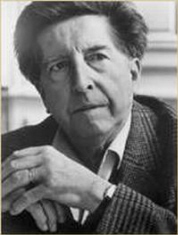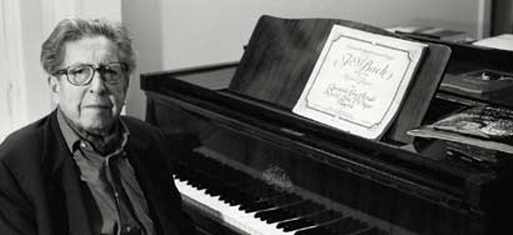|
|
Henri Dutilleux (Composer) |
|
Born: January 22, 1916 - Angers, France
Died: May 22, 2013 - Paris, France |
|
Henri Dutilleux was one of the most important French composers of the second half of the 20th century, producing work in the tradition of Maurice Ravel, Claude Debussy, and Albert Roussel, but in a style distinctly his own. Although his output was relatively small, its high quality and originality won international praise. |
|
Life |
|
As a young man, Henri Dutilleux studied harmony, counterpoint and piano with Victor Gallois at the Douai Conservatory before leaving for Paris. There from 1933 to 1938 he attended the classes of Jean and Noël Gallon (harmony and counterpoint), Henri-Paul Busser (composition) and Maurice Emmanuel (history of music) at the Paris Conservatoire.
Henri Dutilleux won the Prix de Rome in 1938 for his cantata L'Anneau du Roi but did not complete the entire residency in Rome due to the outbreak of World War II. He worked for a year as a medical orderly in the army and then came back to Paris in 1940 where he worked as a pianist, arranger and music teacher and in 1942 conducted the choir of the Paris Opera.
Henri Dutilleux worked as Head of Music Production for French Radio from 1945 to 1963. He served as Professor of Composition at the École Normale de Musique de Paris from 1961 to 1970. He was appointed to the staff of the Paris Conservatoire in 1970 and was composer in residence at Tanglewood in 1995. His students include French composers Gérard Grisey and Francis Bayer, Canadian composer Jacques Hétu, British composers Kenneth Hesketh and Andrew McBirnie, and American composers Derek Bermel and David S. Sampson. |
|
Influences and Style |
|
Henri Dutilleux's music extends the legacies of earlier French composers like Debussy and Ravel but was also clearly influenced by Béla Bartók and Igor Stravinsky. His attitude towards Serialism was more problematic. While he always paid attention to the developments of contemporary music and incorporated some serialist techniques into his own compositions, he also denounced the more radical and intolerant aspects of the movement. As an independent composer, Dutilleux always refused to be associated with any school. Rather, his works merge the traditions of earlier composers and post-World War II innovations and translate them into his own idiosyncratic style. His music also contains echoes of jazz as can be heard in the double bass introduction to his First Symphony and his frequent use of syncopated rhythms.
Some of Dutilleux's trademarks include very refined orchestral textures, fluid and intricate rhythms, a preference for atonality and modality over tonality, the use of pedal points that serve as atonal pitch centers and "reverse variation" by which a theme is not exposed immediately but rather revealed gradually, appearing in its complete form only after a few partial, tentative expositions. His music also displays a very strong sense of structure and symmetry. This is particularly obvious from an "external" point of view i.e. the overall organisation of the different movements or the spatial distribution of the various instruments but is also apparent in the music itself (themes, harmonies and rhythms mirroring, complementing or opposing each other). Most of his works have a dreamlike, highly poetic quality, which makes them relatively more accessible than those of many other post-World War II composers.
Henri Dutilleux's music was often influenced by art and literature, such as by the works of the painter Vincent van Gogh, poet Charles Baudelaire and novelist Marcel Proust. It also shows a concern for the concepts of time and memory, through the use of quotations (notably from Béla Bartók, Benjamin Britten and Jehan Alain) and short interludes which recall material that was used in earlier movements and/or introduce ideas that will be fully developed later.
A perfectionist with an acute sense of artistic integrity, he allowed only a small number of his works to be published, and what he does publish he often revises and adjusts even after. |
|
Music |
|
Henri Dutilleux numbered as Op. 1 his Piano Sonata (1946-1948), written for pianist Geneviève Joy whom he had married in 1946. He renounced most of the works he composed before it because he did not believe them to be representative of his mature standards, considering many of them to be too derivative to have merit. After the Piano Sonata, Dutilleux started working on his First Symphony (1951). It consists of four monothematic movements and has a perfectly symmetrical structure: music slowly emerges from silence (1st movement) and builds towards a fast climax (2nd), keeps its momentum (3rd) and finally slowly fades out (4th).
In 1953, Dutilleux wrote the music for the ballet Le Loup. It was a considerable success which made him known to a wider audience. In his Second Symphony, titled Le Double (1959), the orchestra is divided into two groups: a small one at the front with instruments taken from the various sections (brass, woodwinds, strings and percussions) and a bigger one at the back consisting of the rest of the orchestra. Although this brings to mind the Baroque concerto grosso, Dutilleux clearly stated that that was not the idea behind the work. Rather, the smaller ensemble acts as mirror or a ghost for the bigger one, sometimes playing similar or complementary lines, sometimes contrasting ones. His next work, Métaboles (for orchestra, 1965) explores the idea of metamorphosis, how a series of subtle and gradual changes can radically transform a structure. A different section of the orchestra dominates each of the first four movements before the fifth brings them all together for the finale. It is one of Dutilleux's best known and most acclaimed compositions.
In the mid-1960's, Dutilleux met Mstislav Rostropovich who commissioned him to write a cello concerto. Mstislav Rostropovich premiered the work, titled Tout un monde lointain, in 1970. It is one of the most important additions to the cello repertoire of the 20th century. In five movements, Tout un Monde Lointain is a nocturnal, mysterious work with a delicate orchestration and an eerily beautiful, yet highly virtuosic solo part. While most of the concerto is introspective and meditative, it also has occasional outbursts of violence and a frantic build-up to the ambiguous, suspended finale.
After the cello concerto, Dutilleux turned to chamber music for the first time in more than 20 years and published various works for piano (Figures de Résonances, 3 Préludes) and the important 3 Strophes sur le Nom de Sacher (1976) for solo cello. But his most remarkable work of that era is the string quartet Ainsi la Nuit (1976). Each of its movements highlights various special effects (pizzicato, glissandi, harmonics, extreme registers, contrasting dynamics…) resulting in a difficult but fascinating work, which is among Dutilleux's very best.
He then returned to orchestral works in 1978 with Timbres, Espace, Mouvement ou la Nuit Etoilée, inspired by Vincent Van Gogh's The Starry Night. In this composition, Dutilleux attempted to translate in musical terms the opposition between emptiness and movement conveyed by the painting with strikingly successful results. He achieved this by using a strings section without violins and violas - thus consisting only of the lower-register instruments: cellos and double basses. In 1985, Isaac Stern premiered L'Arbre des Songes, a violin concerto that he had commissioned Dutilleux to write. Like its cello counterpart, it is an essential addition to the instrument's 20th century repertoire.
Dutilleux later wrote Mystère de l'Instant (for cymbalum, string orchestra and percussions, 1989), Les Citations (for oboe, harpsichord, double bass and percussion, 1991), The Shadows of Time (for orchestra and childrenvoices, 1997), Slava's Fanfare (for Mstislav Rostropovich's 70th birthday, 1997) and Sur le Même Accord (for violin and orchestra, 2002 - dedicated to Anne-Sophie Mutter). In 2003, he completed Correspondances, a song-cycle inspired by poems and letters by Prithwindra Mukherjee, Rilke, Solzhenitsyn and Van Gogh. This work received a very enthusiastic reception and has been programmed several times since its première.
Even when he was over 90, Henri Dutilleux was busy composing another song-cycle entitled Le Temps L'Horloge, for American soprano Renée Fleming. It will be based on texts by Charles Baudelaire and Jean Tardieu. The première was planned for September 2007. He also expressed the wish to write more chamber music, a genre which he felt he had neglected. |
|
Awards and Prizes |
|
Grand Prix de Rome (for his cantata L'Anneau du Roi) - 1938
Grand Prix National de Musique (for his entire oeuvre) - 1967
Praemium Imperiale (Japan - for his entire oeuvre) - 1994
Prix MIDEM Classique de Cannes (for The Shadows of Time) - 1999
Ernst Von Siemens Musikpreis (for his entire oeuvre) - 2005 |
|
Works |
|
Orchestral:
Symphony No. 1 (1951)
Symphony No. 2 Le Double (1959)
Métaboles (1964)
Timbres, Espace, Mouvement ou la Nuit Etoilée (1978)
Mystère de l'Instant (1989)
Slava's Fanfare for spatial ensemble (1997)
Concertante:
Cello Concerto Tout un Monde Lointain (1970)
Violin Concerto L'Arbre des Songes (1985)
Nocturne for Violin and Orchestra Sur le Même Accord (2002)
Chamber/Instrumental:
Sarabande et Cortège for bassoon and piano (1942)
Flute Sonatina (1943)
Au Gré des Ondes for piano (1946) (*)
Oboe Sonata (1947)
Piano Sonata (1948)
Choral, Cadence et Fugato for trombone and piano (1950)
Tous les Chemins for piano (1961)
Bergerie for piano (1963)
Résonances for piano (1965)
Figures de Résonances for piano (1970)
3 Préludes for piano (1973-1988)
String Quartet Ainsi la Nuit (1976)
Trois Strophes sur le Nom de Sacher for solo cello (1976-1982)
Les Citations for oboe, harpsichord, double bass and percussions (1991)
Vocal:
Cantata L'Anneau du Roi (1938) (*)
Quatre Mélodies for voice and piano (1943) (*)
La Geôle for voice and orchestra (1944) (*)
Deux Sonnets de Jean Cassou, for baritone and piano (1954)
San Francisco Night, for voice and piano (1963)
The Shadows of Time, for 3 children voices and orchestra (1997)
Correspondances, for soprano and orchestra (2003)
Le Temps l'Horloge, for soprano and orchestra (2007)
Ballet:
Le Loup (1953)
(*) Dutilleux disowned most of these works, written before his Piano Sonata |
|





|
|
More Photos |
|
Sources:
Wikipedia Website
Contributed by Teddy Kaufman (June 2007); Aryeh Oron (April 2017) |
|
Henri Dutilleux : Short Biography | Piano Transcriptions: Works | Recordings |
|
Links to other Sites |
|
Henri Dutilleux (Wikipedia) [English]
Henri Dutilleux (Wikipédia) [French]
Dutilleux, Henri (Schott Music)
Henri Dutilleux (Karadar)
Henri Dutilleux Biography (Naxos)
Henri Dutilleux (Answers.com)
Dutilleux, Henri (Encyclopaedia Britannica)
Classical Source: Henri Dutilleux at 85
Henri Dutilleux (Living Composers Project)
Henri Dutilleuc (Composition Today)
Contemporary Classical: Henri Dutilleux
Henri Dutilleux: biographie (Médiathèque de l'Ircam) [French]
The Ensemble Sospeso: Henri Dutilleux |
|
Bibliography |
|
Caroline Potter : "Dutilleux, Henri", The New Grove Dictionary of Music and Musicians, ed. S. Sadie and J. Tyrrell (London: Macmillan, 2001), vii, 770-772
Henri Dutilleux: His Life and Works. Aldershot (UK) (Ashgate Publishing Company, 1997)
Henri Dutilleux: Mystère et Mémoire des Sons - Entretiens avec Claude Glayman (Actes Sud, 1997)
Caroline Rae: Henri Dutilleux and Maurice Ohana: Victims of an Exclusion Zone? Tempo 212 (April 2000): 22-30 |
|
|